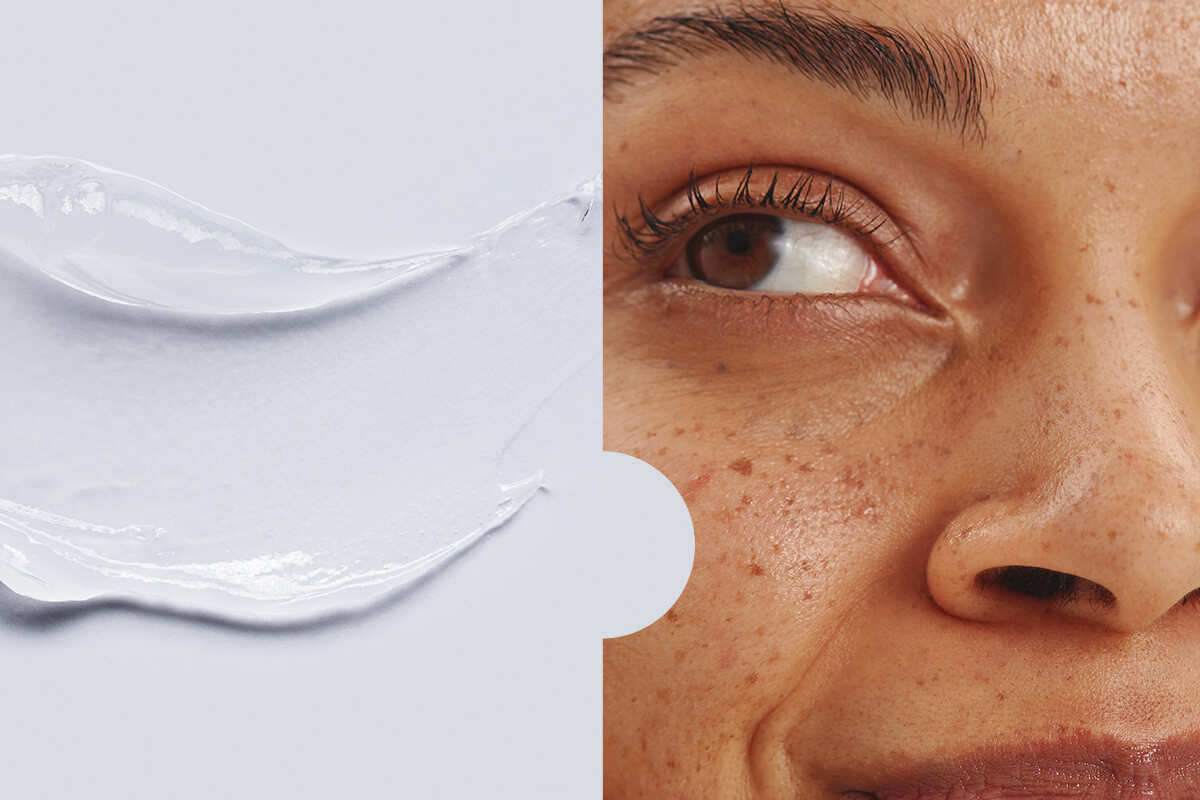Finding effective skincare for stubborn dark spots, melasma, or uneven skin tone is possible without invasive procedures, but we understand how it can often be a long and frustrating journey. Particularly during the summer, these brown or grey patches – although harmless – can reappear or darken. To keep them at bay, you may want to consider adding a serum with tranexamic acid into your skincare routine.
Read on to understand how a tranexamic acid serum works, how it helps treat chronic pigmentation conditions like melasma, and how to add it to your routine for the best results.
What Is Tranexamic Acid?
Tranexamic acid (often referred to as TXA for short) is derived from the amino acid lysine, and was traditionally used to prevent heavy menstrual bleeding, or in surgery and dental procedures to stop excess bleeding. Topical (applied to the skin) TXA has also shown significant promise in the treatment of melasma. (2) It improves skin brightness, and is safe and effective for almost all skin types including sensitive and rosacea-prone skin.
Unlike the prescription ingredient hydroquinone, TXA is available over the counter. Some people may also make this their preferred serum over other actives because you don’t need downtime or breaks from this ingredient in the same way as hydroquinone, either.
Benefits Of Tranexamic Acid Serum
Reduces Hyperpigmentation And Dark Spots
By inhibiting the production of melanin, which is the pigment responsible for dark spots, it can help even out the skin tone.
Helps Lighten The Appearance Of Melasma
Melasma can be triggered by UV exposure, hormonal changes and heat. Tranexamic acid can lighten these uneven patches without risking side effects from long term use, whereas hydroquinone (the current gold standard treatment for melasma) isn’t. (3)
Minimises Redness And Inflammation
TXA isn’t just useful for inhibiting excess melanin in the skin, it also has anti-inflammatory properties. By helping to reduce redness and irritation in the skin, it suits sensitive and reactive skin types and may lower the risk of post-inflammatory hyperpigmentation for people with acne-prone skin.
Enhances Overall Skin Tone And Texture
Regularly using a tranexamic acid serum will help improve the look of dull skin and promote brighter, more even and clearer skin.
How Tranexamic Acid Works
It works by blocking an enzyme in your skin called plasmin. This enzyme is part of the inflammatory process that leads to excess melanin production. By inhibiting plasmin, tranexamic acid reduces how much excess melanin is formed in the skin – lightening existing dark spots and preventing new ones from forming. (4)
Who Should Use Tranexamic Acid Serum?
To improve the appearance of hyperpigmentation conditions like melasma or post inflammatory hyperpigmentation, adding a tranexamic acid serum to your skincare routine could be transformative.
It’s a particularly helpful option if you have sensitive skin that’s prone to redness, if you need to take a break from hydroquinone, or you’re intolerant to hydroquinone.
Although side effects are rare, you may still experience them if your skin is particularly sensitive or reactive. If you think this may affect you, discover more about patch testing and potential adverse reactions here.
How To Use Tranexamic Acid Serum
We recommend applying tranexamic acid once per day when you just start using it, and up to a maximum of two times per day if your skin is tolerating active ingredients well. This is to avoid overloading your skin barrier and potentially causing skin irritation. Find out more about recommended tranexamic acid dosage and strengths here.
Morning routine
If you have a Dermatica personalised formula, or active ingredients in your routine generally, it’s best to apply a tranexamic acid serum in the morning before Vitamin C and sunscreen. If this is the case for you, only add a tranexamic acid serum to your routine if your skin is tolerating all the active ingredients in your routine well, and you have no current or lasting side effects.
This same rule applies even if you have tranexamic acid in your personalised formula.
– Cleanse: Caring Squalane Cream Cleanser or Balancing Glycerin Gel Cleanser
– Treat: Tranexamic Acid Serum
– Protect: Vitamin C 15%: Fresh Batch Ascorbic Acid
– Protect: SPF50 Photodamage Defence Sunscreen (or any sunscreen with SPF30+ that’s compatible with active ingredients)
Evening routine
We always recommend using retinoids or actives, like a Dermatica personalised formula, in the evening. Using these at the same time of day as a tranexamic acid serum could irritate or damage your skin.
However, if you don’t have retinoids or other actives in your routine, using a tranexamic acid serum in the evening is best.
If you’re not using retinoids, actives or a Dermatica personalised formula in the evening, we recommend this evening routine:
– Cleanse: Caring Squalane Cream Cleanser or Balancing Glycerin Gel Cleanser
– Treat: Tranexamic acid serum
– Moisturise: Nourishing Ceramide + Peptide Moisturiser or Soothing Centella Gel Moisturiser
Compatibility With Other Skincare Products
Tranexamic acid can be used with other active ingredients, including:
– AHAs like glycolic acid, lactic acid or mandelic acid
– BHAs like salicylic acid
– Retinoids, retinol or retinaldehyde
– Hydroquinone
– Vitamin C, or Vitamin C derivatives
– Niacinamide
– Kojic acid
– Ferulic acid
Unless recommended for your skin by a licensed dermatology professional, try to avoid using too many active ingredients at the same time of day, or introducing too many new ingredients to your routine at once.
Add new active ingredients to your routine gradually, and observe any changes to your skin. If side effects like irritation, redness, swelling or stinging recur for longer than 1-2 weeks, reduce the number of times a week you use it or remove the product from your routine. This will help avoid adverse reactions.
How Long Does It Take To See Results?
Visible results will depend on your individual skin type and the condition you’re trying to treat. Most people can expect to see a noticeable difference to their skin within 6-12 weeks if they use their product consistently.
In a 2021 study, subjects saw promising visible results in as little as 2 weeks.(5)
At Dermatica, tranexamic acid is a key ingredient option in our personalised formulas. We offer the widest range of active ingredients, and every treatment for hyperpigmentation we recommend is backed by rigorous evidence and research.
Visit the Dermatica website today to discover what our dermatology experts advise for your skin.
References
1. Hurskainen R, Leminen H. Tranexamic acid for the treatment of heavy menstrual bleeding: efficacy and safety. International Journal of Women’s Health [Internet]. 2012 Aug;413. Available from: https://www.ncbi.nlm.nih.gov/pmc/articles/PMC3430088/
2. Ebrahimi B, Naeini FF. Topical tranexamic acid as a promising treatment for melasma. Journal of Research in Medical Sciences : The Official Journal of Isfahan University of Medical Sciences [Internet]. 2014 Aug 1;19(8):753–7. Available from: https://www.ncbi.nlm.nih.gov/pmc/articles/PMC4235096/
3. Basit H, Godse KV, Al Aboud AM. Melasma [Internet]. PubMed. Treasure Island (FL): StatPearls Publishing; 2023. Available from: https://www.ncbi.nlm.nih.gov/books/NBK459271/
4. Batra J, Brar B, Kumar S, Arora H. Tranexamic acid in melasma: Comparative evaluation of therapeutic efficacy of oral tranexamic acid versus its transepidermal administration. Journal of Cutaneous and Aesthetic Surgery. 2022;15(4):394.
5. da Silva Souza ID, Lampe L, Winn D. New topical tranexamic acid derivative for the improvement of hyperpigmentation and inflammation in the sun-damaged skin. Journal of Cosmetic Dermatology [Internet]. 2021 Feb 1;20(2):561–5. Available from: https://pubmed.ncbi.nlm.nih.gov/32588531/
Ash Sharma
Dr Ashwin Sharma is a medical doctor and writer with a particular interest in health technology, artificial intelligence and medical weight loss. He completed his training at the University of Leicester and Imperial College London, and has since been exploring the intersections of medicine, technology, and communication.





